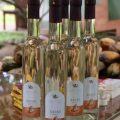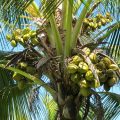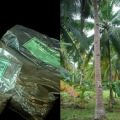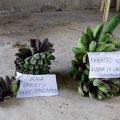Banana and cacao have something in common – they grow best when under shade. Thus, simultaneously growing these crops between coconut trees offer an alternative source of food and income for coconut farmers.
In Quezon Province, PCARRD’s Techno Gabay Program supports two concurrent Science and Technology-based Farm (STBF) projects on banana-coconut and cacao-coconut.

A group from PCARRD headed by Dr. Arturo S. Argañosa together with Mr. Gil Flores of the Federation of Free Farmers (FFF) visited the project sites in Quezon on January 19 to monitor the STBFs’ progress.
Cacao planting materials (Trinitario and Forastero clones) are temporarily housed at the nursery shed of the Department of Agriculture-Quezon Agricultural Experiment Station (DA-QAES) in Tiaong, Quezon. The seedlings, when ready for planting, will be distributed among the FFF cooperators as coconut intercrops during the expansion period.
According to Mr. Dennis Bihis, the cacao project leader, half of the 1,600 cacao plants in the nursery are ready for planting, while the other half requires another month of seedling preparation. The cacao seedlings came from the farm of Magsasaka Siyentista Ireneo Ortega in Apayao, Mountain Province.
Dr. Concepcion Amat, chief of DA-QAES, said that the STBF on cacao production complements DA-Bureau of Agricultural Research’s Cacao Commercialization Project. Both projects contribute significantly in attaining the 50-hectare target cacao expansion in Quezon. To date, DA-QAES has planted in more than 10 hectares.
On the other hand, Lakatan seedlings were distributed for the banana-coconut project. Among the recipients of seedlings is Mr. Miguel Ada, an FFF member in Dolores Quezon. Sadly, the intercropped banana plants in Ada’s farm became infested with coconut grub.
Some plants in Ada’s farm eventually recovered after systemic insecticides were applied.Those that did not survive were replaced with tissue cultured banana seedlings.
Based on field observation, the grub infestation was triggered and aggravated by the animal manure fertilizer used in nearby farms. Incidentally, animal manure is a good breeding ground for the grubs of coconut beetles.
To ensure a steady supply of tissue-cultured lakatan seedlings for their members in Laguna and Quezon, FFF established a new nursery in Santa Cruz, Laguna. The nursery houses 9,600 two-month old banana seedlings from the meriplants obtained from the Lapanday Tissue Culture Laboratory in Davao.






